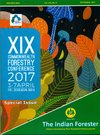Status, Challenges and Future of Urban Forestry in Chandigarh
DOI:
https://doi.org/10.36808/if/2017/v143i9/118870Keywords:
Chandigarh, Landscaping, Challenges, Future, Pilkhan.Abstract
Designed by Le- Carbusier, Chandigarh- The city beautiful, is known for its unique architecture and well planned landscaping. The trees have been planted along roads, in parks and gardens and due regard has been given to beautiful shrubs and climbers. A number of beautiful avenues with conspicuous tree species, green belts running across the length and breadth of the city impart unique aesthetic beauty to the city, hence the name city beautiful. The city however, is now facing lot of challenges. viz migration of rural poor to fringe areas of the city, who still continue with rural life, and are more concerned with the economic value of trees than their aesthetic sense; widening of roads for accommodating vehicular traffic; demand for parking space and tiling&concreting. These are all putting lot of pressure on existing vegetation. As a result, the urban forestry scenario is changing in the city. The species planted close to residential areas during establishing Chandigarh township, have grown to their full capacity and are causing hazards as these trees with their expanded crown, have reached to the residential buildings. Their roots are spreading and are making the buildings unsafe. The branches often break during thunder storms putting many lives to risk. The biggest hurdle are the overhead electricity wires. The branches are regularly chopped off to prevent short circuits. As result, trees lose their natural shape, become disoriented and easily fall prey to storms, insects and fungi. In view of these challenges, species occupying less space and possessing shade and sun considerations need to be explored. Most affected will be Wavy Leaved Fig (Ficus virens) as many roads have been identified with it. People's response to existing species, emerging new pests and possible future species for different landscapes have also been discussed.References
Chander J. (2015). First record of gall forming jumping plant louse, Trioza fletcheri, Crawford, on Terminalia arjuna in Haryana nurseries and plantations. Indian Forester, 141(3): 349-351.
Singh C., Wattas R. and Dhillon H.S. (1999). Trees of Chandigarh- A Book.
Chandigarh Master Plan 2031. Chandigarh, The City Beautiful. The official website of Chandigarh administration. Chandigarh.gov.in/cmp_2031.htm. pp. 226-230.
Lakshmanan (2012). Planning of Chandigarh by Le Corbusier. https://www.slideshare.net/ctlachu/planning-of-chandigarh-by-le-corbusier.
Singh I. (2016). Chandigarh Green Action Plan, 2016. Chandigarh Forest Department, Chandigarh.
Downloads
Downloads
Published
How to Cite
Issue
Section
License
Unless otherwise stated, copyright or similar rights in all materials presented on the site, including graphical images, are owned by Indian Forester.





